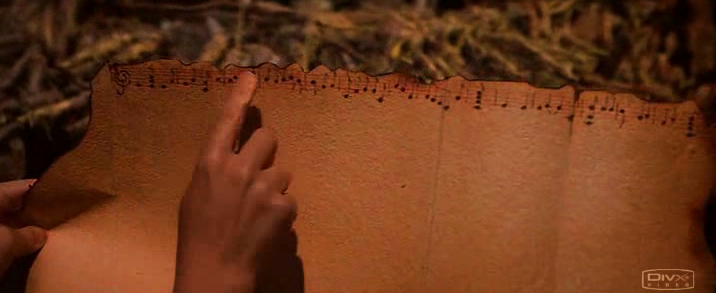
Sadly, there are no Cyndi Lauper widgets to be found here, although her syncopated breath and synth-drums carried many scenes of The Goonies (1985). Nor will David Grusin’s film score be featured, other then his false notation for One-Eyed Willie’s bone organ. No, this here has little to do with traditional music, for the most memorable Goonie Tune isn’t a tune at all per se, but it sure is a melody―an inadvertent movie melody that will go down in history with such classics as Mrs. Doubtfire‘s “Heeee-llo!” and A League of Their Own‘s “Has anyone seen my new red hat?”. Listen to Lotney belt it out below.
Sloth’s famous battle cry occupies the interval of a Whole Tone. Beginning on F# with the “Hey”, the melody bends down two steps to resolve on the E with the “Guys”. If we take his first note as the Root, and the latter as Dominant 7th, we can fit Sloth’s melody into the key of F# Mixolydian. The guitarist’s chord F#7(add11) will work nicely underneath the first and last tones of “Hey You Guys”. Try dragging over the chord above, and clicking the melody on in time.
When I remember this melody, it seems smaller than it actually is, and whenever I hear someone quoting it, it usually only covers a Half Tone interval. This melodic compression of our memories mirrors our natural development as an atonal-talking culture, whereby the giant intervallic leaps we once took as children, are squished and flatted out to a monotonous droning in our adulthood. As you can see and hear above, Sloth’s interval is huge, and can most accurately be transcribed into our 12-TET tuning as a Minor Third (Between the G and the E on “Guys”). Minor Thirds are big child-like intervals, found in Nana Nana Poo Poo and the like, but seldom appear in our conversational tones, except perhaps in flirtation and sarcasm. Sloth, is of course, protector of the children, and sole adult Goonie, though his deformity preserves his child-like mind, and his battle cry of love beseeches our melodic pasts. For more, read about the development of playground melodies.
Now, on to Willy’s bone organ.
The Musical Death Trap scene above is full of flubs, perhaps to evoke Andy’s musical illiteracy. Then again, Willy’s score is preposterous (pictured atop) and looks like some simple C-Major piano exercises. Yeah right! We know Willy only gets down with Flatted Major Chords (and synth-drums). Drag over the chords below. Keep in mind, that Willy’s organ is a few cents flat, as is expected from shoddy Pirate Tuning. Arrrr…
Andy gets the first chord right―a Db Major, but she misses the B-flat Major twice. It sounds like she hits a Bb7(b9) instead, which is basically the same as a Bb Major except it includes a sharpened root up top. Andy nervously shouts “A-flat” right before she hits a B-flat Major. Was their some miscommunication on set, or did Spielberg meddle with this scene?
When Data bumps into Andy at the organ, he presses down on several adjacent keys creating a dissonant chord like at “???”, the kind of music cats like to play. Finally, Andy’s Fake-Out Chord that she denotes as “A, C#, and D”, is not actually played on the bone organ, but would sound like an incomplete D Major 7th. The Musical Death Trap resolves on a strong G Major. G is for Goonie.
Despite the growing popularity of death traps in modern cinema, there is a surprising lack of the musical variety. Most of our musical torture is reserved for animals (See the Cat Organ, see Catgut, see Every Musical Instrument’s ingredients). Even the Saw heptalogy failed to include one Musical Death Trap―a tom-tom drum stretched of human skin, or even an FAO Schwarz-sized Piano of Pain. I suppose, just being exposed to musical education in school, and these shitty little black noteheads like so many insects aswarm, was painful enough.
In closing, I would be remiss if I didn’t at least mention the Ballad of Jake Fratelli, affectionately known by fans as “Nim Bob Da”.
Ok. So what did we learn today?
1) Lauperian breathing is a lost musical device that desperately needs resurgence.
2) Sloth sings like you used to when you were a child.
3) Musical Death Traps are the best way to seek mastery in the tonal arts, so strap yourself in and play to the pain!




how I love thee.
Indeed. Something new for next time…